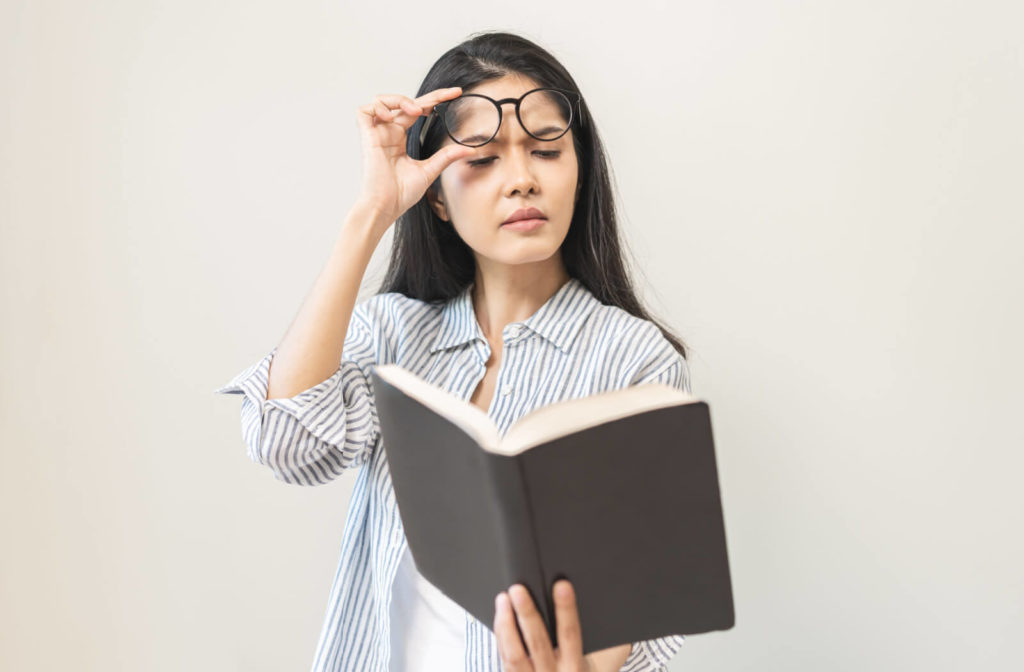Myopia and hyperopia are common refractive errors many patients develop. Eye doctors frequently prescribe glasses and contact lenses to treat these conditions, even though myopia and hyperopia affect the eyes differently.
Understanding what causes these refractive errors can help you and your family’s eyes stay healthy.
Key Differences Between Myopia & Hyperopia
The main difference between myopia and hyperopia is how they affect a patient’s vision: myopia causes blurry vision when looking at distant objects, while hyperopia causes blurry vision when looking at nearby images.
Besides the difference in blurry vision, myopia can progress and significantly affect a patient’s sight and eye health later in life.
What Is Myopia (Nearsightedness)?
Myopia is a condition where close-up objects appear clear, but faraway images appear blurry. It occurs when light rays land in front of the retina instead of directly on the retina, causing blurred distance vision. Myopia usually develops in childhood and is corrected with glasses or contact lenses.
Symptoms of myopia include:
- Eye strain
- Blurry vision
- The need to squint to see clearly
Children with myopia may not realize they have any issues because it can develop early in childhood, and they may have no concept of clear vision to compare it to. However, they may struggle in school, frequently rub their eyes, or sit close to the television or at the front of the classroom, signalling that it may be time to visit your eye doctor.
What Causes Myopia?
Myopia develops due to eye shape—with the eyes growing too long or the cornea having a steep curve, leading to poor focusing as light enters the eye. Besides the shape of the eye, other factors related to myopia development include:
Myopia Can Lead to More Than Blurry Vision
Myopia typically develops in childhood when someone is still growing, which means this condition can progress. Someone’s sight can worsen for years, potentially causing a mild case of myopia to progress into a more severe version called high myopia.
A patient has high myopia when they need significant vision correction to see clearly. However, poor vision isn’t the only risk associated with high myopia—patients are at an increased risk of several eye conditions.
Someone with high myopia is at risk of:

What Is Hyperopia (Farsightedness)?
Hyperopia, also known as farsightedness, is a refractive error where distant objects appear clear while close-up images appear blurry. It occurs when images focus behind the retina instead of on it.
Hyperopia symptoms include:
- Blurry vision
- Eye strain
- Headaches
- Tired eyes
- Difficulty reading close-up words
What Causes Hyperopia?
The opposite of myopia—hyperopia develops when the eyes are too short, or there are issues with the shape of the cornea. Hyperopia isn’t directly hereditary, but you may be more likely to develop it if your parents have this condition.
How Do You Treat Refractive Errors?
Since refractive errors are common, treating them is often straightforward. Depending on your vision needs, your optometrist can recommend glasses or contact lenses to help improve your sight. Many lenses are available to meet your needs, and your optometrist’s office can help you find stylish frames to accompany your new lenses.
If you don’t want to rely on corrective lenses, many patients opt for laser eye surgery. Your eye doctor can determine your eligibility for this treatment and refer you to a trusted surgeon. They’ll also be available throughout the healing process to help your eyes recover well.
Myopia Progression Needs a Different Form of Treatment
While traditional glasses and contact lenses can help correct myopia, they cannot help control myopia progression. Essentially, glasses can only provide clear vision—myopia will still progress in children without preventive measures from an eye doctor.
If your child has progressive myopia, your optometrist can perform an eye exam to determine the best treatments for their needs. They can provide a comprehensive treatment plan that helps correct and control myopia, slowing myopic progression to protect your child’s vision and eye health.
Don’t Let Refractive Errors Prevent Clear Vision
Myopia and hyperopia affect your vision, making everyday life more difficult. However, glasses and contact lenses can help you and your family see more clearly. Your optometrist is here to help—they can recommend the best lenses for your unique needs.
Contact us at Visionary Eye Centre if you experience symptoms of a refractive error.







